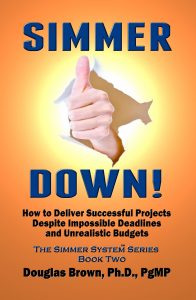How to Deliver Great Projects Despite Impossible Deadlines and Unrealistic Budgets.
Unrealistic? Perhaps. Impossible? Probably not. Either way, that's all you're getting. What's a project manager to do?
One of the most frequent complaints among project managers is that best practices such as PMBoK and PRINCE say that you should work out what a project is about first, then estimate the work needed to do it, then determine the likely cost and schedule.
In reality, it often happens that project managers are nominated to their roles and told what the deadline is and how much money is available, and that's the end of that. Many go through the best practice processes they have learned, and discover that you simply can't get there from here: there simply isn't any way to deliver what's required in the allotted time and budget. But their program managers or executives won't budge an inch: the budget is formulated, the shareholder or stakeholder promises have been made. Suck it up. Do more with less. That's why we hired a great PM like you, to make things happen, get it done ... We've heard it all before. No wonder project failure rates are what they are. Is there no end to the madness?
Well, yes, there is. Simmer Down explains what a project manager can do when faced with such a situation so as to end up satisfying both the customer and the constraints. It's also going to be useful to help program managers explain to the project managers that sometimes the world does not revolve around them. Let's face it, there can only be one project that is priority A-1. Everything else has to revolve around that fact, and managing that thought process is the way to make sense out of all the impossible contradictions.
This book explains how a project gets on the board in the first place, and provides many tips on how a project manager can influence the action in the early stages, the planning stages and even after work begins to obtain and maintain the most reasonable possible expectations for cost, schedule and scope.
Dr. Brown shares the lessons of over 20 years of experience in project and program planning and execution in both commercial and government settings. In all that time, more money up front has seldom been an option; better understanding of what the stakeholders can get for the money that they do have is the way to go
This book is offered to the project management community at the least cost that the printers will allow. In return, all we ask is for your e-mail address.
